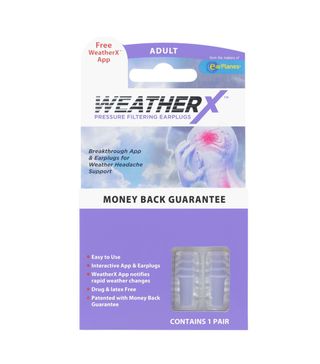The Weather May Be Causing Your Tension Headaches—Here's How to Deal

You know how Karen Smith (played by Amanda Seyfried) of Mean Girls has the "superpower" of being able to predict the weather by feeling her breasts? Well, I have a similar situation—except it's not quite as flirty and it causes me intense physical pain. For the past six years, I've struggled with barometric pressure headaches triggered by weather changesd. And it's actually a pretty common issue.
Seemingly out of the blue, I started getting excruciating headaches just above my left eye. Advil—my usual go-to for head pain—didn't help at all. Nor did steaming my face, resting, or drinking tons of water. My headaches in the past were caused by fevers or sinus pressure. This was different, and I couldn't figure it out. When I looked up "causes of migraines," the symptoms didn't seem to check out: I wasn't sensitive to light, I wasn’t dizzy, and I wasn't having blurred vision. But it was painful enough that I couldn’t go out and function without feeling terribly uncomfortable. It caused plenty of tears.
I saw an ENT doctor, who offered me a steroid spray for my sinuses, which I refused. "This is not a sinus problem," I thought. My nose was perfectly clear. This cycle went on for almost two years.

So I did what any millennial journalist with working internet and a laptop would do: I googled the shit out of it. Deep into message board threads, people mentioned that they journaled when their one-sided headaches happened. When they analyzed the data, many found a link between their head pain and weather changes. The term "barometric pressure headache" was thrown out, and I knew that was my answer.
Looking back, I realized my headaches always came when it was about to rain, the air became very dry, or the temperature dramatically shifted from warm to cool (or vice versa). Still, I journaled and logged my headaches for months until I determined—with evidence!—that this had to be the case. And after understanding what was going on, I was finally able to manage them and feel better.
That said, it wasn't until I chatted with Alexander Mauskop, MD, a doctor who works at the New York Headache Center that I realized my headaches were actually migraines. (Proof you should always get a second medical opinion.) Keep reading for his advice on diagnosing a barometric headache—plus, how to manage the pain.
What Is a Barometric Pressure Headache?

First, let's understand what a barometric pressure change is. Essentially, barometric pressure is the force put on our bodies by the air around us. Examples of barometric pressure changes include when a storm is coming, it's very windy, or we reach high altitudes, like flying on a plane or going skiing in the mountains. According to Mauskop, when this drops, it can affect us. For people who are sensitive to barometric pressure change, it can cause headaches.
Now let's take a closer look at types of headaches. "We classify headaches based on the description that you give us, meaning there is no objective test to prove that you have a migraine or a tension-type of headache," Mauskop explains.
A tension headache is the most common kind and can usually be helped with OTC meds like ibuprofen. They are often caused by stress, alcohol, and lack of sleep.

Mauskop says most of the barometric pressure headaches are actually migraines (which explains why regular Advil didn't help me). "There are numerous triggers for migraines," he says. "These include stress (a big one), lack of sleep, certain foods, menstrual cycle, and barometric pressure." Also, some people are extra susceptible to migraines if they have genetic predispositions.
A study published in 2017 by The Journal of Oral Rehabilitation found a positive association between migraine pain levels and atmospheric pressure, linking the two as cause and effect. So, yes—the weather may very well be causing your splitting headache.
Also, women are more likely than men to get migraines. "It's been known for decades from large research studies that women are three times as more likely to get migraines than men," said Mauskop. "That's a proven, well-established old fact." The World Health Organization credits this to hormonal fluctuations.
How to Know If It's Happening to You

If you're into biology, you'll appreciate this scientific description of what happens inside your head when you feel discomfort. As stated in Medical News Today: "researchers think that changes in atmospheric pressure cause a pressure difference between the sinus cavities, the structures and chambers of the inner ear, and the outside world. These pressure changes can cause persistent pain, especially in small, confined, air-filled systems, such as the sinus and ear chambers. Increasing external pressure may also cause blood vessels to dilate and abnormal blood flow to the brain, increasing the risk of a headache or a migraine."
Since you can't look inside your head to see what’s happening, try to figure it out based on symptoms. Mauskop says that if you're experiencing one or more of the following, you likely have a migraine: "These features include unilateral headaches (it's on one side), throbbing quality of pain, associated nausea, sensitivity to light, sensitivity to noise, and [difficulty] with movement (like running up the steps)."
Personally, I feel the pressure on one side and can get a bit nauseous. Always talk to your doctor if the situation is at all unclear.
There's an App for That

You can't control the weather, as Mother Nature has her own plans. But you can get ahead of barometric weather changes. Most of what I learned explained that it’s important to take medicine as soon as you experience symptoms. This helped me dramatically. An app called WeatherX Forecast offers two solutions: special earplugs to help with discomfort and barometric pressure forecasts.
"The app can be very useful because it can send you an alert when barometric pressure drops by 20 millibars, which is the common threshold for migraines," Mauskop notes. "You can actually send alerts to yourself for smaller or greater barometric pressure changes depending on how sensitive you are, but 20 millibars is the standard one." The value of the apps is it tells you a warning—usually before you develop a headache—so you can either use the earplugs, take medicine, or both.
Finding the Right Meds

Speaking of medicine, it was essential for me to find what works. I got lucky because over-the-counter tension headache medicine (Excedrin) works for me. It usually either dulls or completely eliminates the pain, and after about eight hours (two doses), my headache is gone. "If OTC medicine like ibuprofen or naproxen help, that's great," Mauskop advises. "If they don't, we have prescription drugs." Those who think they may need prescription migraine drugs should consult with a doctor.
Holistic Advice

There are also alternative ways to deal with head pain. While there are no specific ones for barometric pressure headaches, there are methods for migraines. "We recommend preventative regular exercise, which conditions your blood vessels and muscles,” says Mauskop.
He also suggests getting your stress levels down. "Very often it is not a single trigger, like weather, but multiple triggers,” he explains. "If you are under stress, dehydrated, hungry, or sleep deprived, then the weather could just be an additional trigger that will bring on a migraine.”
That, he explains, is why people sometimes cannot easily identify these causes—such as the weather—because one trigger by itself may or may not be sufficient.
Neuroscientist and wellness expert Leigh Winters offers additional, common-sense advice. "Rest! If over-the-counter meds are proving fruitless, put down your phone, step away from the computer or anything that might be straining your eyes, and take a break,” she says. "If you’re feeling up to it, take a walk outside for some fresh air.”
She also recommends simple breath work and meditation, which we know helps with the S word (being stress). "Add a few drops of peppermint essential oil to a cotton ball or into the palm of your hands and inhale,” she adds. "There is recent research demonstrating that peppermint oil works as acute therapy for tension headaches.”
Just remember: This headache is not just "in your head” even if you physically feel it there.

Next up: 7 Editors Share the One Buy That Helps Them De-Stress
This article was originally published at an earlier date and has since been updated.
Disclaimer
This article is provided for informational purposes only and is not intended to be used in the place of advice of your physician or other medical professionals. You should always consult with your doctor or healthcare provider first with any health-related questions.


